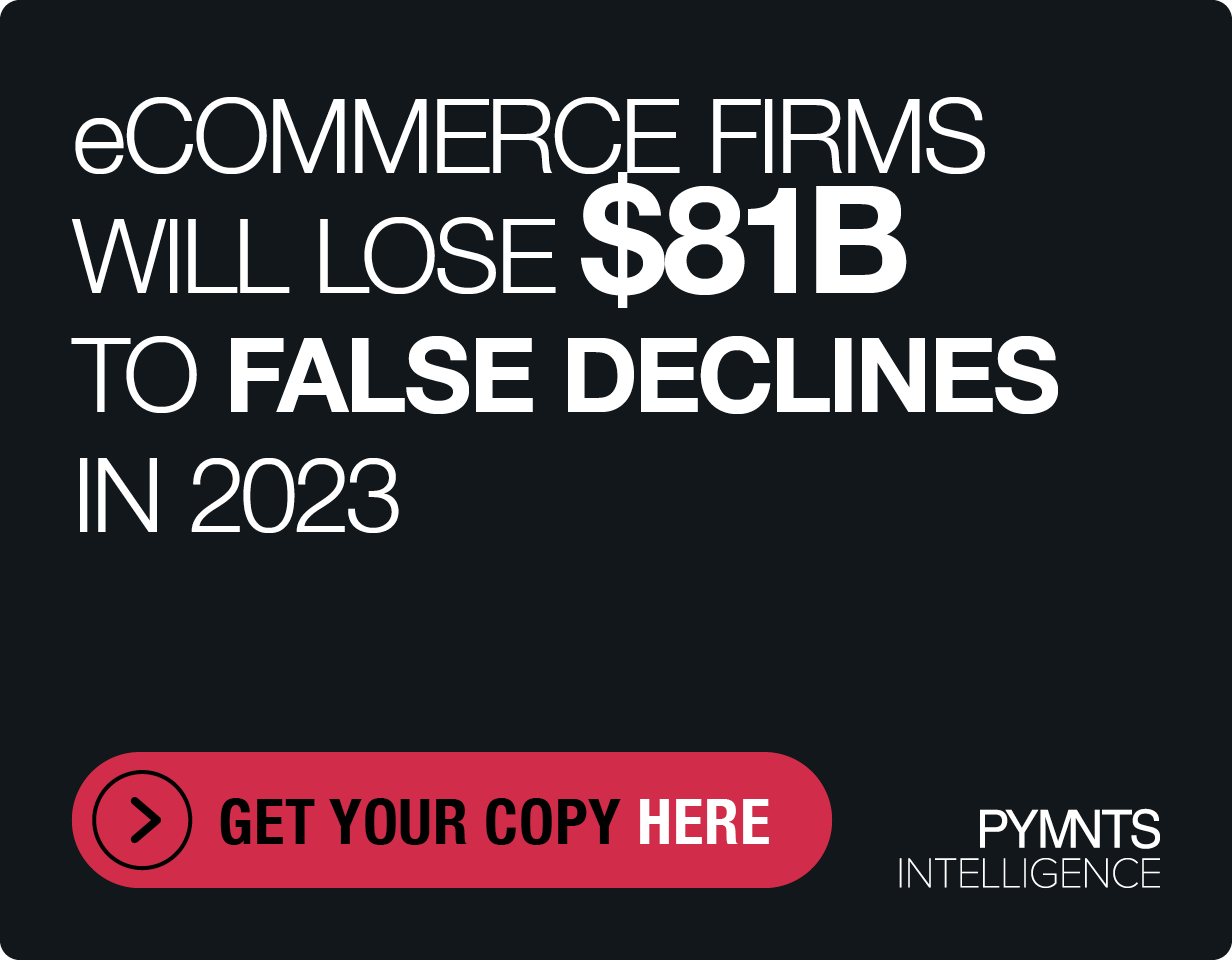Is AR Having Its ‘Netflix Moment?’

CDs in paper wrappers, delivered via the mail was the Netflix model until 2007 when they made the move to digital. AR departments, Billtrust CFO Ed Jordan told a #PYMNTalk live audience recently, are facing their own “Netflix Moment” as digital invoice-to-cash solutions emerge. So, is AR ready to make the same move?
The invoice-to-cash journey is having its Netflix Moment, as Billtrust CFO Ed Jordan likes to say.
Netflix pre-2007 was a manual, paper-based system — relying entirely on manual shipping, manual returns and absolutely no customer self-service. The only way that a customer could get a DVD was to have it mailed to them in a little red package and to return it once the movie had been watched.
This not only put a heavy manual burden on the company’s employees, some of which were expected to stuff envelopes at a rate of 1,000 per hour, but also on customers, who had no choice but to use the postal service to receive and return DVD rentals.
By the time the mid-2000s rolled around, Netflix’s stock price had plateaued, and innovation was needed to take its business to another level.
Through an effort to embrace technology and make a pivot to digital, Netflix was able to break out of its rut and bring customers a disruptive offering: digital delivery and streaming media across a variety of media — essentially taking manual out of the equation.
Netflix’s digital transformation required two parallel efforts: having the network and infrastructure in place to handle the change and then providing the delivery mechanism into the network.
Jordan believes that the same can be said for the pivot to digital taking place in the accounts receivable space today.
“It’s interesting to me, anyway, that Netflix and others companies, like Amazon, have taken a lot of what we used to do manually and moved it to a digital medium. We’ve seen the same thing in the digital invoice-to-cash journey as well,” he explained.
Much like Netflix, AR departments manually print invoices, stuff them into envelopes and drop them off at the post office. This manual process not only takes up valuable time and resources but adds a ton of cost — mailing invoices in-house can be quite expensive.
With a recent Billtrust survey finding that approximately 50 percent of businesses have not implemented a solution for sending electronic invoices, the time for a digital change is here.
Jordan recently joined Karen Webster for a live roundtable discussion on some of the hottest digital trends, speed dating-style.
A recap of the webinar event is below:
Automating Invoice-To-Cash
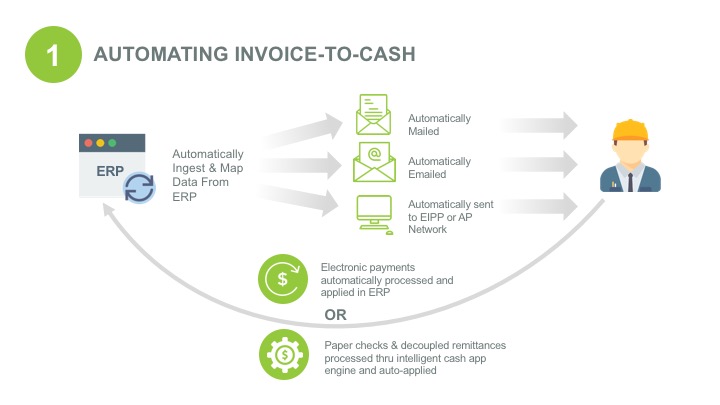
Though everyone around them seems to be embracing automation, Jordan explained that AR departments have been stuck. Their processes are both dated and inefficient.
He noted that the biggest challenge is that customers want to receive their invoices in a variety of different ways — printed and mailed, emailed, faxed, posted to an electronic portal, etc. On the back end, they also want to be able to make payments using the method that is most convenient to them, whether that be paper checks, ACH transactions or even using credit cards.
Being able to digitize, automate and modernize these processes, which have traditionally been quite disjointed and siloed, can be very hard to pull together.
But Jordan explained that there are solutions in place that can provide the ability and flexibility needed to deliver invoices to customers in any format that they like with one simple interface in their ERP system. Billtrust’s Payment Cycle Management is one such solution.
Using technology to streamline the presentation of invoices may not take as much change management as corporates may think, because the automation helps to solve for many of the inherent inefficiencies.
“There’s no reason that this process can’t be automated, and we’ve been successful in doing that. It’s just a matter of getting adoption by customers and their clients to move electronically,” Jordan added.
Advances In Cash Application
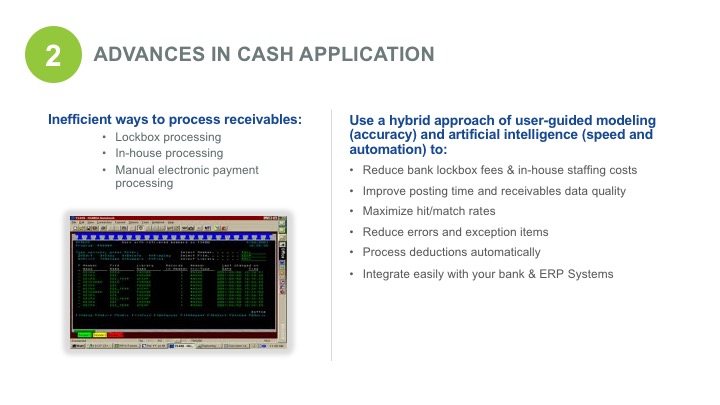
Jordan noted that there’s been some big advancements in cash application technology over the past few years, with software now able to automate many parts of this process and help to reduce inefficient methods.
But an interesting question was posed: Are lockbox operations an obvious target for receivables disruption?
When it comes to lockbox processing in particular, which Jordan pointed out comes with high codes and manual keying, which can lead to many efforts, advances in cash application may help to capture many matches overlooked by using the traditional system.
With a much higher match rate and reducing the need of the lockbox fees, Jordan said a solution that interfaces with both the ERP and the file from the bank can improve posting times and data quality.
“It’s more about making sure the customer’s account is cleared, because the last thing you want to do is have a customer who has paid you something not have it applied properly and now a credit manager is calling to ask them for the payment or putting them on credit hold,” Jordan explained.
Being able to approve cash quickly can be very significant from a customer satisfaction perspective.
B2B Payment Trends
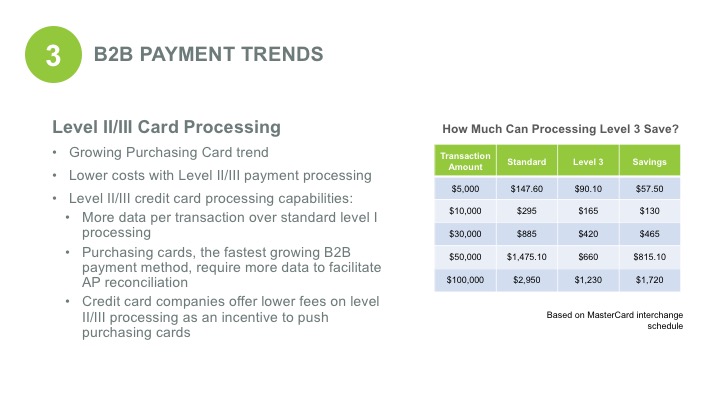
As AP departments adopt automated technology to optimize and manage payables, they are in need of more accurate data and have grown to expect a wide range of transaction details when making payments, Jordan pointed out.
They are also on a mission for cost savings when it comes to card processing, which is why many opt for Level II/III card processing. Jordan said that one of the biggest drivers of the decision to go this route is the desire for lower interchange.
“Once again, it’s about providing the customer with the flexibility to pay the way they want to pay, when they want to pay, but in order to make that efficient in a B2B environment, you need to have a lower cost solution, which Level II/III provides,” he added.
Today, many are providing their customers with the ability to process credit cards for transactions, where, in the past, a business selling to businesses was looking for an ACH payment or a paper check payment, they just didn’t offer credit card solutions.
Purchasing cards or eCards has become a popular option, allowing a business to keep pace with its competitors who are facilitating card payments.
Jordan explained that there is technology available that can impose a variety of limits on how or when cards are accepted, providing a great deal of control and flexibility.
Network-Based Payment Solutions
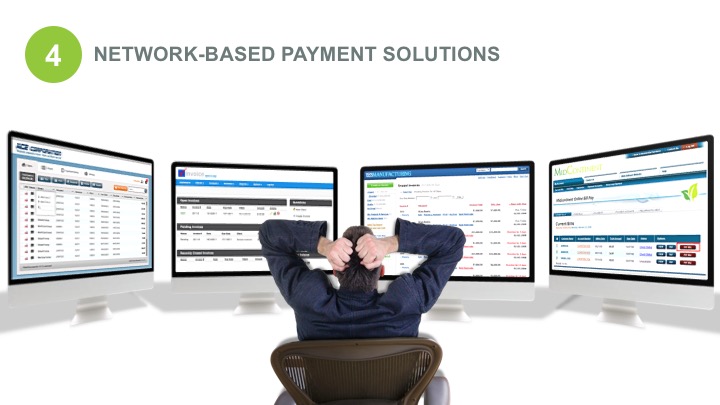
There are a number of complexities that come with managing the many ways buyers and suppliers want to pay and be paid, while also supporting the payment methods that underpin that.
But electronic invoice-to-cash solutions aim to remove the burden that used to exist in the AP department by automating the processes and internal workflows. Many AP departments have even pushed back on the way they receive invoices — no longer accepting paper invoices and instead requiring a supplier to go into a portal and process an invoice directly.
The problem with that is suppliers can be forced to log in to multiple portals to pay invoices, depending on the type of business they operate, leaving them with a time-consuming process.
Using the network-based payments approach allows Billtrust to create end points in its network of AP portals in order to process invoices automatically, Jordan said. The system can even filter and interface with a client that wants an invoice sent directly to an AP network.
AP networks leverage the power of the network effect; as more businesses become a part of the network, the network itself becomes more valuable to everyone.
Jordan pointed out that most large and mid-sized companies are moving in this direction, if they haven’t already, though it may not be the best option for small companies that don’t receive a lot of invoices.
The Customer Experience
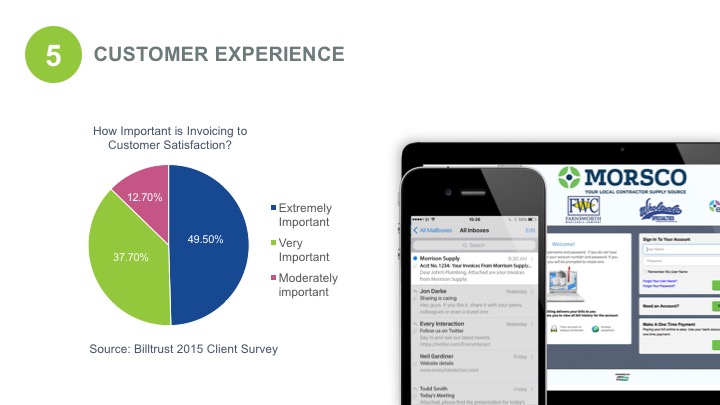
The ubiquity of new technology has reset customer expectations, creating a new standard for speed of service and user experience, Jordan said.
“It’s all about clear, concise invoices delivered the way that the end customer wants to receive them and the ability to make payments against those invoices in a self-service way,” he added.
According to Billtrust’s survey data, nearly 49.5 percent of its clients said that invoicing is extremely important to customer satisfaction, with 37.7 percent noting it is very important.
Invoices must, first and foremost, have the data that the client needs. Jordan noted that the ability to customize this information is significant, and to do that in the right way, a business must have great integration into the ERP system and provide bills in many different ways.
Between the ROI from lowered costs, improved accuracy and greater customer satisfaction improvement, Jordan added that moving to an automated invoice-to-cash solution can really lay a foundation for increased benefits.
Accelerating Electronic Adoption
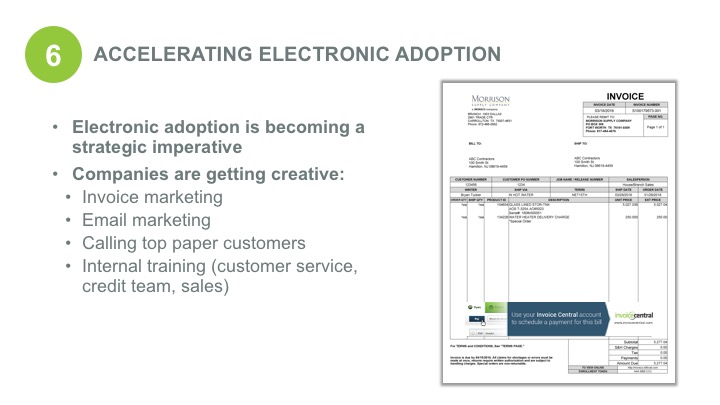
Though there’s still a lot of paper in the invoice-to-cash process, and there probably will be for some time, Jordan is optimistic that, in the not-so-distant future, that may no longer be the case.
“We might have paper out of the system within 10 years. But the key to it is really twofold: suppliers embracing the move to electronic and the exercise of really helping those suppliers educate their customers on why they should receive electronic instead of paper,” he said.
Educating suppliers so that they can pass that knowledge onto their paper-based customers is key. This involves communicating the benefits that can come with electronic adoption and automated processes, which include lower cost of processing, improved cash flow, greater customer satisfaction and more detail behind invoices.
Jordan drew on the example of a Billtrust customer that was able to go from no electronic processing to 25 percent electronic invoice-to-cash adoption in just 12 months.
“It’s interesting because it doesn’t really matter too much the size of the company or the number of invoices; it’s a matter of them being committed to making it work,” he explained.
Much like with the Netflix analogy, the network and infrastructure must also be there to help enable greater electronic adoption.
“It’s also about having the right technology running on those networks to make sure it’s seamless on the front end and back end,” Jordan said.
